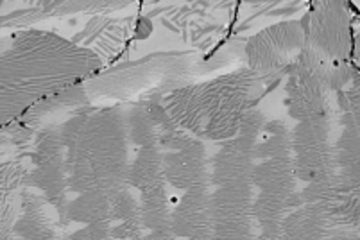All genres
61.
Journal Article
Strain rate dependence of the slip transfer through a penetrable high angle grain boundary in copper. Scripta Materialia 138, pp. 88 - 91 (2017)
62.
Journal Article
Compressed Bi-crystal micropillars showing a sigmoidal deformation state – A computational study. Materials Science and Engineering A: Structural Materials Properties Microstructure and Processing 700, pp. 168 - 174 (2017)
63.
Journal Article
Dislocation interaction and twinning-induced plasticity in face-centered cubic Fe–Mn–C micro-pillars. Acta Materialia 132, pp. 162 - 173 (2017)
64.
Journal Article
Thickness dependence of the electro-mechanical response of sputter deposited Mo thin films on polyimide: Insights from in situ synchrotron diffraction tensile tests. Materials Science and Engineering A: Structural Materials Properties Microstructure and Processing 697, pp. 17 - 23 (2017)
65.
Journal Article
Single-shot full strain tensor determination with microbeam X-ray Laue diffraction and a twodimensional energy-dispersive detector. Journal of Applied Crystallography 50 (3), pp. 901 - 908 (2017)
66.
Journal Article
Dislocation-twin boundary interaction in small scale Cu bi-crystals loaded in different crystallographic directions. Acta Materialia 129, pp. 91 - 97 (2017)
67.
Journal Article
Size effect in bi-crystalline micropillars with a penetrable high angle grain boundary. Acta Materialia 129, pp. 312 - 320 (2017)
68.
Journal Article
Beam-induced atomic migration at Ag-containing nanofacets at an asymmetric Cu grain boundary. Journal of Materials Research 32 (5), pp. 968 - 982 (2017)
69.
Journal Article
Microcantilever Fracture Testing of Intermetallic Cu3Sn in Lead-Free Solder Interconnects. Journal of Electronic Materials 46 (3), pp. 1607 - 1611 (2017)
70.
Journal Article
Mechanical size effects in a single crystalline equiatomic FeCrCoMnNi high entropy alloy. Scripta Materialia 129, pp. 52 - 55 (2017)
71.
Journal Article
Effect of annealing on the size dependent deformation behavior of thin cobalt films on flexible substrates. Thin Solid Films 624, pp. 34 - 40 (2017)
72.
Journal Article
Pre- and post-buckling behavior of bi-crystalline micropillars: Origin and consequences. Acta Materialia 124, pp. 195 - 203 (2017)
73.
Journal Article
Stress intensity factor dependence on anisotropy and geometry during micro-fracture experiments. Scripta Materialia 127, pp. 76 - 78 (2017)
74.
Journal Article
Konkurrenzlose Festigkeit durch extremes Umformen von Stahl. Stahl und Eisen 137 (8), p. 58 - 58 (2017)
75.
Journal Article
Maintaining strength in supersaturated copper–chromium thin films annealed at 0.5 of the melting temperature of Cu. Journal of Materials Science 52 (2), pp. 913 - 920 (2017)
76.
Journal Article
Strain-induced phase transformation of a thin Co film on flexible substrates. Acta Materialia 121, pp. 227 - 233 (2016)
77.
Journal Article
Superlattice effect for enhanced fracture toughness of hard coatings. Scripta Materialia 124, pp. 67 - 70 (2016)
78.
Journal Article
Analysis of the full stress tensor in a micropillar: Ability of and difficulties arising during synchrotron based μLaue diffraction. Materials and Design 108, pp. 68 - 75 (2016)
79.
Journal Article
Fracture toughness of intermetallic Cu6Sn5 in lead-free solder microelectronics. Scripta Materialia 123, pp. 38 - 41 (2016)
80.
Journal Article
Deformation-Induced Martensite: A New Paradigm for Exceptional Steels. Advanced Materials 28 (35), pp. 7753 - 7757 (2016)











